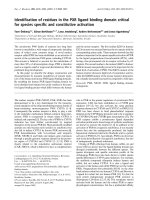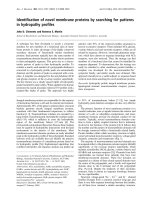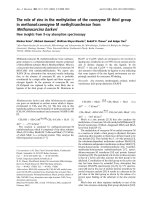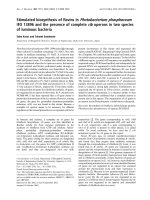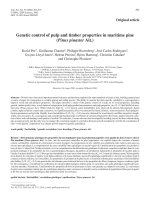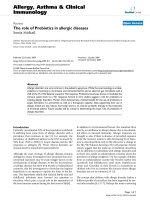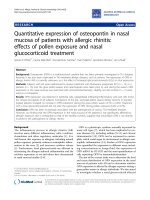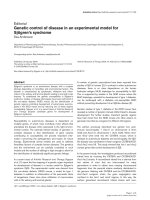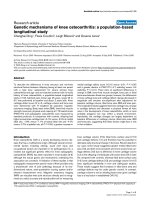Báo cáo y học: "Genetic control of disease in an experimental model for Sjögren’s syndrome Åsa Andersson" potx
Bạn đang xem bản rút gọn của tài liệu. Xem và tải ngay bản đầy đủ của tài liệu tại đây (44.28 KB, 2 trang )
Available online />Page 1 of 2
(page number not for citation purposes)
Abstract
Sjögren’s syndrome is an autoimmune disease with a complex
etiology depending on hereditary and environmental factors. The
disease is characterized by lymphocytic infiltration and inflam-
mation in the salivary and lacrimal glands, leading to oral and ocular
dryness. To understand the genetic susceptibility in Sjögren’s
syndrome, studies of disease phenotypes have been performed in
the non-obese diabetic (NOD) mouse. By the identification of
genetic regions controlling development of autoimmune exocrino-
pathy in the NOD mouse and by reducing one of these regions
considerably, Nguyen et al. in a recent issue of Arthritis Research
and Therapy propose candidate genes for development of
Sjögren’s syndrome.
Susceptibility to autoimmune diseases is dependent on
multiple genes, of which most contribute minor effects that
precipitate the disease when expressed in the right environ-
mental context. The rationale behind studies of genetics in
complex diseases is that identification of gene variants
contributing to susceptibility will provide important infor-
mation concerning the pathogenesis and hopes for future
therapy. Experimental animal models are used to address
hereditary factors of complex human diseases. The genetics
and the environment can be carefully controlled in such
models and the number of siblings is high enough to allow for
the identification of statistically significant genetic linkage.
In a recent issue of Arthritis Research and Therapy, Nguyen
et al. [1] report the fine mapping of a genetic region important
for development of disease in a mouse model for Sjögren’s
syndrome (SjS). The experimental model was derived from
the non-obese diabetic (NOD) mouse, a model for type 1
diabetes. In addition to inflammation of the pancreatic islets
of Langerhans, these mice show infiltration of mononuclear
cells in the salivary and lacrimal glands.
A number of genetic associations have been reported from
studies of SjS in humans [2]. In contrast to other autoimmune
diseases, there is no clear dependence on the human
leukocyte antigen (HLA) haplotype for susceptibility to SjS.
This is supported by studies in the NOD mouse where the
MHC haplotype, essential for development of type 1 diabetes,
can be exchanged with a diabetes non-susceptible MHC
without preventing development of an SjS-like disease [3].
Genetic studies of type 1 diabetes in the NOD mouse have
revealed a number of genetic intervals (Idds) linked to disease
development. For further studies, important genetic regions
have been bred from the NOD mouse into other strains, to
generate mice that are congenic for different Idd regions.
The authors previously described two genetic loci, auto-
immune exocrinopathy 1 (Aec1) on chromosome 3 (from
Idd3) and Aec2 on chromosome 1 (from Idd5). When Aec1
and Aec2 were bred into the C57Bl/6 mouse, which is
resistant to autoimmune diabetes and exocrinopathy, the SjS-
like disease was manifested in these congenic C57Bl/6.NOD-
Aec1Aec2 mice [4]. This study showed that Aec1 and Aec2
contain genes that control development of SjS.
In the present study, the investigators produced recombinant
inbred lines by crossing the C57Bl/6 and C57Bl/6.NOD-
Aec1Aec2 strains. A recombinant inbred line is derived from
two strains of mice that are intercrossed for many
generations in order to obtain mice carrying chromosomal
fragments from the parental strains randomly distributed in
the genome. Starting with C57Bl/6 and the C57Bl/6.NOD-
Aec1Aec2 congenic strain, the gene segregation was
confined to the Aec1 and Aec2 regions. In this way, the
authors generated recombinant inbred strains with over-
Editorial
Genetic control of disease in an experimental model for
Sjögren’s syndrome
Åsa Andersson
Department of Pharmacology and Pharmacotherapy, Faculty of Pharmaceutical Sciences, Copenhagen University, Universitetsparken 2,
DK-2100 Copenhagen Ø, Denmark
Corresponding author: Åsa Andersson,
Published: 20 January 2009 Arthritis Research & Therapy 2009, 11:102 (doi:10.1186/ar2583)
This article is online at />© 2009 BioMed Central Ltd
See related research by Nguyen et al., />cM = centiMorgan; NOD = non-obese diabetic; SjS = Sjögren’s syndrome.
Arthritis Research & Therapy Vol 11 No 1 Andersson
Page 2 of 2
(page number not for citation purposes)
lapping Aec2 intervals. The recombinant inbred mice were
subsequently investigated for SjS disease phenotypes: saliva
production, sialadenitis, and anti-nuclear antibodies. By this
strategy, the critical genetic interval, containing a gene (or
genes) controlling the disease traits, could be reduced from
approximately 70 to 10 centiMorgans (cM), located 80 cM
from the centromere on chromosome 1 [1].
Dissections of disease loci in models for autoimmune
diseases have shown that one locus can contain more than
one gene linked to disease [5,6]. In one study, a locus of
approximately 20 cM contained four sub-loci controlling
disease [6]. Thus, it is possible that the re-defined Aec2 locus
contains more than one gene involved in the disease process.
The shorter Aec2 interval on mouse chromosome 1 includes
loci that are linked to the development of autoimmune
disease in mouse models: Eae27 (experimental autoimmune
encephalomyelitis 27); Stia1 (serum transfer induced arthritis
1); Mbis1 (mycobacterium-induced systemic lupus erythema-
tosus 1). This might suggest shared disease pathways in
different models for autoimmune diseases controlled by the
same genes within this interval.
On the basis of potential candidate genes located within the
re-defined Aec2 interval, the authors elegantly discuss
possible disease pathways. One pathway starts out from the
Tnfsf4 gene encoding the OX40 ligand (OX40L). This
molecule negatively influences the activity of type 1 regulatory
T cells [7,8], thereby possibly contributing to autoimmunity.
The other pathway discussed is based on genes within the
Aec2 locus, important in the homeostasis of lipids,
lipoproteins, cholesterols, and fatty acids. Secondary effects
of impaired lipid homeostasis could result in inflammation and
cell death. Results from a recent gene-expression study support
a role for these genes in autoimmune exocrinopathy [9].
Although the re-defined genetic interval has been considerably
reduced compared to the original Aec2 locus, it still contains
approximately fifty genes. Without direct data on candidate
gene expression in tissues from mice with the smaller Aec2
interval, or investigations of polymorphism in, or close to,
candidate genes from susceptible and resistant mouse strains,
speculations on disease mechanisms has to be considered
preliminary. The re-defined Aec2 locus could most likely be
further reduced by a new breeding program and investigated
for genetic variants influencing development of SjS.
Competing interests
The author declares that they have no competing interests.
References
1. Nguyen CQ, Cornelius JG, Cooper L, Neff J, Tao J, Lee BH, Peck
AB: Identification of possible candidate genes regulating Sjö-
gren’s syndrome-associated autoimmunity: a potential role
for TNFSF4 in autoimmune exocrinopathy. Arthritis Res Ther
2008, 10:R137.
2. Williams PH, Cobb BL, Namjou B, Scofield RH, Sawalha AH,
Harley JB: Horizons in Sjögren’s syndrome genetics. Clin Rev
Allergy Immunol 2007, 32:201-209.
3. Robinson CP, Yamachika S, Bounous DI, Brayer J, Jonsson R,
Holmdahl R, Peck AB, Humphreys-Beher MG: A novel NOD-
derived murine model of primary Sjögren’s syndrome. Arthritis
Rheum 1998, 41:150-156.
4. Cha S, Nagashima H, Brown VB, Peck AB, Humphreys-Beher
MG: Two NOD Idd-associated intervals contribute synergisti-
cally to the development of autoimmune exocrinopathy (Sjö-
gren’s syndrome) on a healthy murine background. Arthritis
Rheum 2002, 46:1390-1398.
5. Johannesson M, Karlsson J, Wernhoff P, Nandakumar KS,
Lindqvist AK, Olsson L, Cook AD, Andersson Å, Holmdahl R:
Identification of epistasis through a partial advanced inter-
cross reveals three arthritis loci within the Cia5 QTL in mice.
Genes Immun 2005, 6:175-185.
6. Karlsson J, Johannesson M, Lindvall T, Wernhoff P, Holmdahl R,
Andersson Å: Genetic interactions in Eae2 control collagen-
induced arthritis and the CD4+/CD8+ T cell ratio. J Immunol
2005, 174:533-541.
7. Ito T, Wang YH, Duramad O, Hanabuchi S, Perng OA, Gilliet M,
Qin FX, Liu YJ: OX40 ligand shuts down IL-10-producing regu-
latory T cells. Proc Natl Acad Sci USA 2006, 103:13138-
13143.
8. Takeda I, Ine S, Killeen N, Ndhlovu LC, Murata K, Satomi S, Suga-
mura K, Ishii N: Distinct roles for the OX40-OX40 ligand inter-
action in regulatory and nonregulatory T cells. J Immunol
2004, 172:3580-3589.
9. Killedar SJ, Eckenrode SE, McIndoe RA, She JX, Nguyen CQ,
Peck AB, Cha S: Early pathogenic events associated with Sjö-
gren’s syndrome (SjS)-like disease of the NOD mouse using
microarray analysis. Lab Invest 2006, 86:1243-1260.
